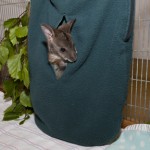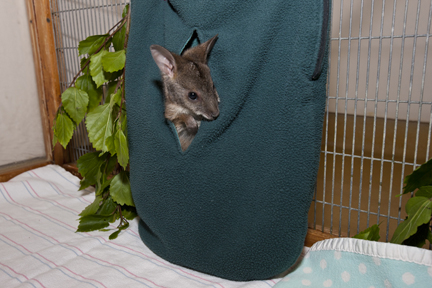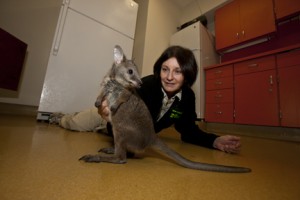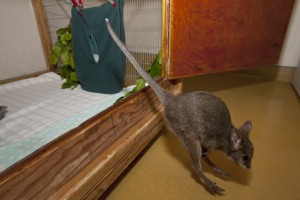Clik here to view.

Clik here to view.

Clik here to view.

Tinka peeks out of her larger pouch.
Be sure to read Janet’s previous post, Wallaby Baby: New Coat, New Adventures.
We knew that Tinka, a parma wallaby, was small for her age since her arrival in the San Diego Zoo’s Neonatal Assisted Care Unit. All along, one of our main focuses was to encourage her to eat and gain weight. We surmised that since her mom had been so ill, either the quantity or quality (or both) of Mom’s milk wasn’t enough for the baby to attain a normal size. We weighed Tinka every morning before her first bottle, and we found that she gained weight nearly every day. Though her weight climbed, it was never enough to compensate, and she remained 30 to 50 percent of normal size range. The statistics we had on normal baby parma growth ended at around 200 days. Now we were in uncharted territory, unable to determine exactly how Tinka was doing.
We noticed that Tinka’s muscular tail and legs were looking more substantial. She developed an endearing little pad of fat under her chin, characteristic of the species. We decided to check with some other zoos to see if there was any weight data available on joeys Tinka’s age. Cooperation between zoos in sharing information like this is vital. There aren’t many zoos that have an organized hand-rearing program. Fewer have experience with marsupials, and even fewer still have had experience with parma wallabies. We were lucky to find that the Cleveland Zoo had raised a parma wallaby recently, had kept excellent records, and were willing to share them with us.
Clik here to view.

Tinka and Janet enjoy some play time in the nursery.
When we compared Tinka’s weight to the animal from Cleveland, we were surprised with what we found: our little girl was now 80 percent normal size! Tinka had been experiencing what is known as compensatory growth, which occurs when a small animal “catches up” to normal weight. We were delighted with this finding.
By now, Tinka was consuming solids well, jumping out of her pouch as soon as a fresh food pan was placed in her enclosure. Her favorite food was freshly chopped greens. She had become so wide (especially across the backside) that she was having trouble wiggling into her small pouch. Her fore end made it through the opening easily, but the back end was a struggle! We provided her with a larger, roomier model made from the same design. Tinka, our once-fragile neonate was now a healthy parma youngster. It was time for her to graduate from the nursery.
Clik here to view.

Tinka hops out of her nursery bedroom.
One of the most common questions I am asked as a nursery keeper is, “Don’t you miss them when they are gone? Aren’t you sad when they leave the nursery?” My answer is always the same. When an animal is ready to move on, it means that we have fulfilled our role. The aim from the start was not to make the animal into our pet, and the focus was never about the relationship between the animal and the keeper. Instead, the focus is on graduating a healthy, well-adjusted animal that will go on to lead a productive life. It is impossible not to look back on rearing an animal without some sense of letting go. But that was the plan all along, and now it was Tinka’s time.
The koala keepers prepared a nice temporary space for Tinka in an off-exhibit area. We outfitted it with some logs and hay and hung a heater above one of her pouches. Though she was used to visiting with the adults and spending time in a pen by herself every day, she returned to the nursery for overnight stays. On December 26, Tinka left the nursery for the last time. That evening, nursery keepers went out to visit Tinka in the early evening to check on her, and she seemed fine. Tinka was settled and stress free the following morning, having spent a comfortable night tucked in her heated pouch.
Tinka continues her socialization. A gentle adult female was selected to serve as a companion, and Tinka spends her days in a warm and sunny pen behind the Zoo’s parma wallaby enclosure. Soon, Tinka will be introduced to all the “girls” in the group. We have decreased her feedings to just one abbreviated bottle in the morning, and her weight continues to climb.
Janet Hawes is a senior keeper at the San Diego Zoo.